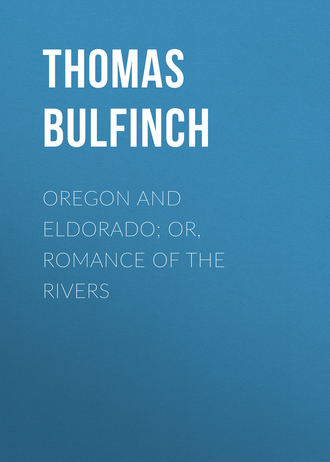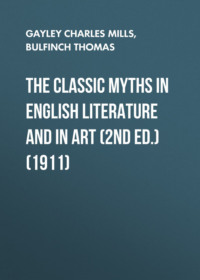 полная версия
полная версияOregon and Eldorado; or, Romance of the Rivers
"Antonio said the depredator was the sucumjú, the Indian name for the anaconda, or great water-serpent, which had for months past been haunting this part of the river, and had carried off many ducks and fowls from the ports of various houses. I was inclined to doubt the fact of a serpent striking at its prey from the water, and thought an alligator more likely to be the culprit, although we had not yet met with alligators in the river. Some days afterward, the young men belonging to the different settlements agreed together to go in search of the serpents. They began in a systematic manner, forming two parties, each embarked in three or four canoes, and starting from points several miles apart, whence they gradually approximated, searching all the little inlets on both sides of the river. The reptile was found at last, sunning itself on a log at the mouth of a muddy rivulet, and despatched with harpoons. I saw it the day after it was killed. It was not a very large specimen, measuring only eighteen feet nine inches in length, and sixteen inches in circumference at the widest part of the body."
ALLIGATORS"Our rancho was a large one, and was erected in a line with the others, near the edge of the sand-bank, which sloped rather abruptly to the water. During the first week, the people were all more or less troubled by alligators. Some half-dozen full-grown ones were in attendance off the praia, floating about on the lazily flowing, muddy water. The dryness of the weather had increased since we left Shimuni, the currents had slackened, and the heat in the middle of the day was almost insupportable. But no one could descend to bathe without being advanced upon by one or other of these hungry monsters. There was much offal cast into the river; and this, of course, attracted them to the place. Every day, these visitors became bolder: at length, they reached a pitch of impudence that was quite intolerable. Cardozo had a poodle-dog named Carlito, which some grateful traveller whom he had befriended had sent him from Rio Janeiro. He took great pride in this dog, keeping it well sheared, and preserving his coat as white as soap and water could make it. We slept in our rancho, in hammocks slung between the outer posts; a large wood fire (fed with a kind of wood abundant on the banks of the river, which keeps alight all night) being made in the middle, by the side of which slept Carlito on a little mat. One night, I was awoke by a great uproar. It was caused by Cardozo hurling burning firewood with loud curses at a huge cayman, which had crawled up the bank, and passed beneath my hammock (being nearest the water) towards the place where Carlito lay. The dog raised the alarm in time. The reptile backed out, and tumbled down the bank into the river; the sparks from the brands hurled at him flying from his bony hide. Cardozo threw a harpoon at him, but without doing him any harm."
THE PUMA"One day, I was searching for insects in the bark of a fallen tree, when I saw a large, cat-like animal advancing towards the spot. It came within a dozen yards before perceiving me. I had no weapon with me but an old chisel, and was getting ready to defend myself if it should make a spring; when it turned round hastily, and trotted off. I did not obtain a very distinct view of it; but I could see its color was that of the puma, or American lion, although it was rather too small for that species.
"The puma is not a common animal in the Amazons forests. I did not see altogether more than a dozen skins in the possession of the natives. The fur is of a fawn-color. The hunters are not at all afraid of it, and speak in disparaging terms of its courage. Of the jaguar they give a very different account."
THE GREAT ANT-EATER"The great ant-eater, tamandua of the natives, was not uncommon here. After the first few weeks of residence, I was short of fresh provisions. The people of the neighborhood had sold me all the fowls they could spare. I had not yet learned to eat the stale and stringy salt fish which is the staple food of these places; and for several days I had lived on rice-porridge, roasted bananas, and farinha. Florinda asked me whether I could eat tamandua. I told her almost any thing in the shape of flesh would be acceptable: so she went the next day with an old negro named Antonio, and the dogs, and, in the evening, brought one of the animals. The meat was stewed, and turned out very good, something like goose in flavor. The people of Caripí would not touch a morsel, saying it was not considered fit to eat in those parts. I had read, however, that it was an article of food in other countries of South America. During the next two or three weeks, whenever we were short of fresh meat, Antonio was always ready, for a small reward, to get me a tamandua.
"The habits of the animal are now pretty well known. It has an excessively long, slender muzzle, and a worm-like, extensile tongue. Its jaws are destitute of teeth. The claws are much elongated, and its gait is very awkward. It lives on the ground, and feeds on termites, or white ants; the long claws being employed to pull in pieces the solid hillocks made by the insects, and the long flexible tongue to lick them up from the crevices."
THE JAGUAROur traveller, though he resided long and in various parts of the Amazon country, never saw there a jaguar. How near he came to seeing one appears in the following extract. This animal is the nearest approach which America presents to the leopards and tigers of the Old World.
"After walking about half a mile, we came upon a dry water-course, where we observed on the margin of a pond the fresh tracks of a jaguar. This discovery was hardly made, when a rush was heard amidst the bushes on the top of a sloping bank, on the opposite side of the dried creek. We bounded forward: it was, however, too late; for the animal had sped in a few minutes far out of our reach. It was clear we had disturbed on our approach the jaguar while quenching his thirst at the water-hole. A few steps farther on, we saw the mangled remains of an alligator. The head, fore-quarters, and bony shell, were all that remained: but the meat was quite fresh, and there were many footmarks of the jaguar around the carcass; so that there was no doubt this had formed the solid part of the animal's breakfast."
PARÁ"I arrived at Pará on the 17th of March, 1859, after an absence in the interior of seven years and a half. My old friends, English, American, and Brazilian, scarcely knew me again, but all gave me a very warm welcome. I found Pará greatly changed and improved. It was no longer the weedy, ruinous, village-looking place that it had appeared when I first knew it in 1848. The population had been increased to twenty thousand by an influx of Portuguese, Madeiran, and German immigrants; and, for many years past, the provincial government had spent their considerable surplus revenue in beautifying the city. The streets, formerly unpaved, or strewed with stones and sand, were now laid with concrete in a most complete manner: all the projecting masonry of the irregularly-built houses had been cleared away, and the buildings made more uniform. Most of the dilapidated houses were replaced by handsome new edifices, having long and elegant balconies fronting the first floors, at an elevation of several feet above the roadway. The large swampy squares had been drained, weeded, and planted with rows of almond and other trees; so that they were now a great ornament to the city, instead of an eye-sore as they formerly were. Sixty public vehicles, light cabriolets, some of them built in Pará, now plied in the streets, increasing much the animation of the beautified squares, streets, and avenues. I was glad to see several new book-sellers' shops; also a fine edifice devoted to a reading-room, supplied with periodicals, globes, and maps; and a circulating library. There were now many printing-offices, and four daily newspapers. The health of the place had greatly improved since 1850, – the year of the yellow-fever; and Pará was now considered no longer dangerous to new-comers.
"So much for the improvements visible in the place; and now for the dark side of the picture. The expenses of living had increased about fourfold; a natural consequence of the demand for labor and for native products of all kinds having augmented in greater ratio than the supply, in consequence of large arrivals of non-productive residents, and considerable importations of money, on account of the steamboat-company and foreign merchants.
"At length, on the 2d of June, I left Pará, – probably forever. I took a last view of the glorious forest for which I had so much love, and to explore which I had devoted so many years. The saddest hours I recollect ever to have spent were those of the succeeding night, when, the pilot having left us out of sight of land, though within the mouth of the river, waiting for a wind, I felt that the last link which connected me with the land of so many pleasing recollections was broken."
THE END1
Dimensions of Niagara Falls, – American, 960 feet wide, 162 feet high; English, 700 feet wide, 150 feet high.
2
There are many stories, from other sources, confirmatory of these noises in mountainous districts. One solution, suggested by Humboldt, – who does not, however, record the fact as of his own observation, – is, that "this curious phenomenon announces a disengagement of hydrogen, produced by a bed of coal in a state of combustion." This solution is applicable only to mountains which contain coal, unless chemical changes in other minerals might be supposed capable of producing a similar effect.
3
Since called the Coast range.
4
Now the site of Omaha City.


